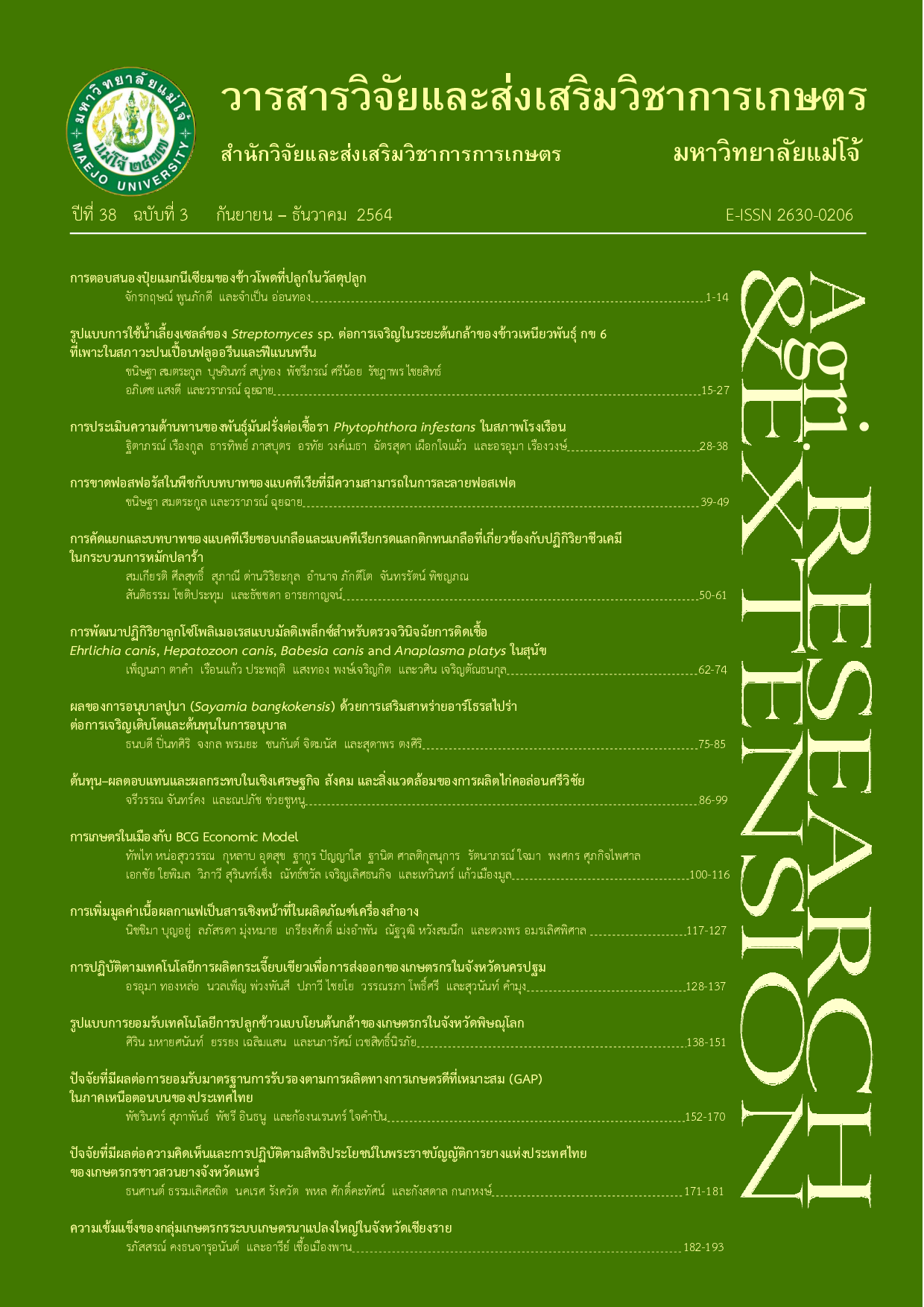การขาดฟอสฟอรัสในพืชกับบทบาทของแบคทีเรียที่มีความสามารถในการละลายฟอสเฟต
คำสำคัญ:
พืชเศรษฐกิจ, แบคทีเรียละลายฟอสเฟต, แบคทีเรียกลุ่มสนับสนุนการเจริญเติบโตของพืชบทคัดย่อ
ฟอสฟอรัสเป็นส่วนประกอบที่สำคัญในสาร ชีวโมเลกุลของพืช รูปที่พบมากในดิน คือ รูปฟอสเฟต อนินทรีย์ แต่เนื่องจากฟอสเฟตอนินทรีย์มักพบในรูปที่ ไม่ละลายน้ำ ทำให้การขาดฟอสฟอรัสเป็นปัญหาที่สำคัญในพืช พืชบางชนิดมีการปรับตัวเพื่อแก้ปัญหาการขาดแคลนฟอสฟอรัสโดยการอยู่ร่วมกับเชื้อราไมคอไรซาและการสร้างรากกลุ่ม (Cluster root) ในขณะที่การเพิ่มการเจริญเติบโตของพืชเศรษฐกิจในสภาวะขาดฟอสฟอรัสด้วยการเพิ่มปุ๋ยฟอสเฟตทำให้เกิดปัญหามลภาวะทางน้ำเพิ่มขึ้น ดังนั้นการใช้แบคทีเรียที่มีความสามารถในการละลายฟอสเฟตกับพืชเศรษฐกิจจึงเป็นวิธีการที่เหมาะสมในการแก้ปัญหามากกว่า ในบทความนี้ได้รวบรวมกลไกและตัวอย่างการใช้แบคทีเรียที่มีความสามารถในการละลายฟอสเฟตทางการเกษตร กลไกสำคัญในการละลายฟอสเฟตได้แก่การสร้างสารเคมี เช่น กรดเพื่อละลายฟอสเฟตอนินทรีย์ และการสร้างเอนไซม์เพื่อละลายฟอสเฟตอินทรีย์ อย่างไรก็ตาม ความสามารถในการละลายฟอสเฟตของแบคทีเรียกลุ่มละลายฟอสเฟต ขึ้นอยู่กับปัจจัยทางสิ่งแวดล้อมหลายประการ
เอกสารอ้างอิง
Alori, E.T., B.R. Glick and O.O. Babalola. 2017. Microbial phosphorus solubilization and its potential for use in sustainable agriculture. Frontiers in Microbiology. 8: 971. [Online]. Available https://doi.org/10.3389/fmicb.2017.00971 (25 October 2020).
Anzuay, M.S., M.G.R. Ciancio, L.M. Ludueña, J.G. Angelini, G. Barros, N. Pastor and T. Taurian. 2017. Growth promotion of peanut (Arachis hypogaea L.) and maize (Zea mays L.) plants by single and mixed cultures of efficient phosphate solubilizing bacteria that are tolerant to abiotic stress and pesticides. Microbiological Research 199: 98-109. [Online]. Available https://doi.org/10.1016/j.micres.2017.03.006 (25 October 2020).
Bakhshandeh, E., H. Pirdashti and K.S. Lendeh. 2017. Phosphate and potassium-solubilizing bacteria effect on the growth of rice. Ecological Engineering 103: 164-169. [Online]. Available https://doi.org/10.1016/j.ecoleng.2017.03.008 (25 October 2020).
Bobeautong, T., N. Insalud, W. Sungpalee and C. Atnaseo. 2017. Effect of phosphorus level on rice root development. Khon Kaen Agricultural Journal 45(Suppl.1): 997-1002.
Chen, Q. and S. Liu. 2019. Identification and characterization of the phosphate-solubilizing bacterium Pantoea sp. S32 in reclamation soil in Shanxi, China. Frontiers in Microbiology 10: 2171. [Online]. Available https://doi.org/10.3389/fmicb.2019.02171 (25 October 2020).
Elias, F., D. Woyessa and D. Muleta 2016. Phosphate solubilization potential of rhizosphere fungi isolated from plants in Jimma zone, southwest Ethiopia. International Journal of Microbiology 2016: 11. [Online]. Available https://doi.org/10.1155/2016/5472601 (25 October 2020).
Ingle, K.P. and D.A. Padole 2017. Phosphate solubilizing microbes: an overview. International Journal of Current Microbiology and Applied Sciences 6(1): 844-852.
Kalayu, G. 2019. Phosphate solubilizing microorganisms: promising approach as biofertilizers. International Journal of Agronomy. 2019: 7. [Online].Available https://doi.org/10.1155/2019/4917256 (25 October 2020).
Ludueña, L.M., M.S. Anzuay, J.G. Angelini, M. McIntosh, A. Becker, O. Rupp, A. Goesmann, J. Blom, A. Fabra and T. Taurian. 2018. Strain Serratia sp. S119: a potential biofertilizer for peanut and maize and a model bacterium to study phosphate solubilization mechanisms. Applied Soil Ecology126: 107-112. [Online]. Available https://doi.org/10.1016/j.apsoil.2017.12.024 (25 October 2020).
Mishra, B.K., K.K. Meena, P.N. Dubey, O.P. Aishwath, K. Kant, A.M. Sorty and U. Bitla. 2016. Influence on yield and quality of fennel (Foeniculum vulgare Mill.) grown under semi-arid saline soil, due to application of native phosphate solubilizing rhizobacterial isolates. Ecological Engineering 97: 327-333. [Online]. Available https://doi.org/10.1016/j.ecoleng.2016.10.034 (25 October 2020).
Onthong, J. and M. Osaki. 2006. Adaptations of tropical plants to acid soils. Tropics 15(4): 337-347.
Péret, B., M. Clément, L. Nussaume and T. Desnos. 2011. Root developmental adaptation to phosphate starvation: better safe than sorry. Trends in Plant Science 16(8): 442-450.
Rezakhani, L., B. Motesharezadeh, M.M. Tehrani, H. Etesami and H.M. Hosseini. 2020. Effect of silicon and phosphate-solubilizing bacteria on improved phosphorus (P) uptake is not specific to insoluble P-fertilized sorghum (Sorghum bicolor L.) plants. Journal of Plant Growth Regulation 39(1): 239-253.
Sarikhani, M.R., B. Khoshru and R. Greiner. 2019. Isolation and identification of temperature tolerant phosphate solubilizing bacteria as a potential microbial fertilizer. World Journal of Microbiology and Biotechnology 35(8): 126.
Satyaprakash, M., T. Nikitha, E.U.B. Reddi, B. Sadhana and S.S. Vani. 2017. Phosphorus and phosphate solubilizing bacteria and their role in plant nutrition. International Journal of Current Microbiology and Applied Sciences 6(4): 2133-2144.
Sharma, S.B., R.Z. Sayyed, M.H. Trivedi and T.A. Gobi. 2013. Phosphate solubilizing microbes: sustainable approach for managing phosphorus deficiency in agricultural soils. Springerplus 2: 587. [Online]. Available https://springerplus.springeropen.com/articles/10.1186/2193-1801-2-587 (25 October 2020).
Shu, L., J. Shen, Z. Rengel, C. Tang, F. Zhang and G.R. Cawthray. 2007. Formation of cluster roots and citrate exudation by Lupinus albus in response to localized application of different phosphorus sources. Plant Science 172(5): 1017-1024.
Sousa, M.F., A.R. Façanha, R.M. Tavares, T. Lino-Neto and H. Gerós. 2007. Phosphate transport by proteoid roots of Hakea sericea. Plant Science 173(5): 550-558.
Suleman, M., M. Yasmin, M. Rasul, M. Yahya, B.M. Atta and M.S. Mirsa. 2018. Phosphate solubilizing bacteria with glucose dehydrogenase gene for phosphorus uptake and beneficial effects on wheat. Plos One 13(9): e0204408. DOI: 10.1371/journal.pone.0204408.
Taurian, T., M.S. Anzuay, J.G. Angelini, M.L. Tonelli, L. Ludueña, D. Pena, F. Ibáñez and A. Fabra. 2010. Phosphate-solubilizing peanut associated bacteria: screening for plant growth-promoting activities. Plant and Soil 329(1-2): 421-431.
Zhang, F.S., J. Ma and Y.P. Cao. 1997. Phosphorus deficiency enhances root exudation of low-molecular weight organic acids and utilization of sparingly soluble inorganic phosphates by radish (Raghanus sativus L.) and rape (Brassica napus L.) plants. Plant and Soil 196(2): 261-264.
Zhang, T., F. Hu and L. Ma. 2019. Phosphate-solubilizing bacteria from safflower rhizosphere and their effect on seedling growth. Open Life Science 14(1): 246-254.
Zheng, B., M. Ibrahim, D. Zhang, Q. Bi, H. Li, G. Zhou, K. Ding, J. Peñuelas, Y. Zhu, and X. Yang. 2018. Identification and characterization of inorganic-phosphate-solubilizing bacteria from agricultural fields with a rapid isolation method. AMB Express 8: 47. [Online]. Available https://amb-express.springeropen.com/articles/10.1186/s13568-018-0575-6 (25 October 2020).
Zhu, Q., H. Wang, Y.Z. Shan, H.Y. Ma, H.Y. Wang, F.T. Xie and X. Ao. 2020. Physiological response of phosphorus-efficient and inefficient soybean genotypes under phosphorus-deficiency. Russian Journal of Plant Physiology 67(1): 175-184.
ดาวน์โหลด
เผยแพร่แล้ว
รูปแบบการอ้างอิง
ฉบับ
ประเภทบทความ
สัญญาอนุญาต
ลิขสิทธิ์ (c) 2021 วารสารวิจัยและส่งเสริมวิชาการเกษตร

อนุญาตภายใต้เงื่อนไข Creative Commons Attribution-NonCommercial-NoDerivatives 4.0 International License.
บทความนี้ได้รับการเผยแพร่ภายใต้สัญญาอนุญาต Creative Commons Attribution-NonCommercial-NoDerivatives 4.0 International (CC BY-NC-ND 4.0) ซึ่งอนุญาตให้ผู้อื่นสามารถแชร์บทความได้โดยให้เครดิตผู้เขียนและห้ามนำไปใช้เพื่อการค้าหรือดัดแปลง หากต้องการใช้งานซ้ำในลักษณะอื่น ๆ หรือการเผยแพร่ซ้ำ จำเป็นต้องได้รับอนุญาตจากวารสาร





